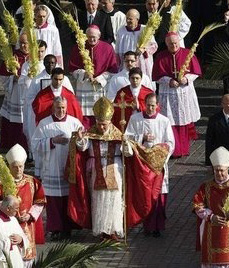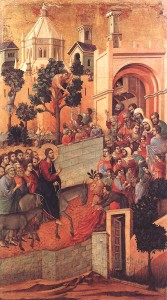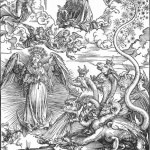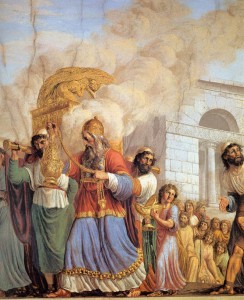Processions Of The Catholic Faithful Are Fully Biblical
 Anti-Catholic commentators, critics and agitators often argue that Roman Catholic processions are pagan, anti-scriptural, and violate the commandments forbidding the making of and worshiping of graven images. These criticisms themselves are unscriptural.
Anti-Catholic commentators, critics and agitators often argue that Roman Catholic processions are pagan, anti-scriptural, and violate the commandments forbidding the making of and worshiping of graven images. These criticisms themselves are unscriptural.
As discussed previously, religious processions are an ancient form of popular piety that accompany the sacramental life of the Church. As stated in Section 1679 of the Catechism of the Catholic Church:
The religious sense of the Christian people has always found expression in the various forms of piety which accompany the sacramental life of the Church such as the veneration of relics, visits to sanctuaries, pilgrimages, processions, the stations of the cross and the rosary. The Church sheds the light of faith upon and fosters authentic forms of popular piety.
Here, the Queen of Angels Foundation’s proposed annual procession in honor of Our Lady of the Angels, and the Angelic Host of which she is Queen by virtue of her role as the Mother of Jesus Christ, who is King of Heaven, is grounded firmly and focused entirely on the Sacred Liturgy of the Mass. As such, its most fundamental foundation is the Holy Scripture itself. Just as Mary accompanied her Son Jesus carrying his cross through the streets of Jerusalem – the via dolorosa – through each station of the cross, for the final consummation in Jesus’ Passion and Sacrifice on the cross at the Crucifixion, so too the participants in the annual procession follow Mary through the streets of Los Angeles, with a processional cross, to the Cathedral, where the Sacred Liturgy and Sacrifice of the Mass reenact Jesus’ Passion and Sacrifice for the benefit of all people. Once it is understood that the Foundation’s Marian Procession is directed to and culminates in the Eucharist and Holy Liturgy accompanying it, it becomes all the clearer that the procession fulfills Jesus’ own command to his apostles:
“This is my body that is for you. Do this in remembrance of me.” In the same way also the cup, after supper, saying, “This cup is the new covenant in my blood. Do this, as often as you drink it, in remembrance of me.” For as often as you eat this bread and drink the cup, you proclaim the death of the Lord until he comes.
“This is my body, which will be given for you; do this in memory of me.”
The feast (reception) following the Procession and Mass celebrates Christ’s resurrection after his Passion, and the role of Mary and the Angelic Host in salvation history, which finds its focal point in the Passion, Crucifixion and Resurrection of Jesus Christ, Mary’s Son.
Thus, Father Deharbe’s 1901 Catechism states, in answer to the question, “Why are processions held?”:
- To make an open profession of the Catholic faith.
- To honor God publically, and to ask His protection and His blessing upon city and country.
- To celebrate the victory and the triumph of Christianity.
Processions are public act of homage to God, giving honor to him, through Christ, the Second Person of the Trinity, and to his Mother, the Theotokos, and the Angelic Host that serve them as ministers of the will of God. Processions are commonly mentioned in the Old Testament, expressing the faith of the people, and Jesus figures at the center of processions in the New Testament, just as he figures at the center of the Foundation’s Procession in honor of Our Lady of the Angels, for her Queenship is derived by the incarnation of her Son and His assumption into heaven as King of Kings.

ADEMOLLO, Luigi, Transportation of the Ark of the Covenant, 1816, Fresco, Galleria Palatina (Palazzo Pitti), Florence
Some of these biblical references of support for processions are noted below.
The New Testament Commends Processions

BLAKE, William, The Book of Job - When the Morning Stars Sang Together, 1820, Watercolour, 280 x 179 mm, Pierpont Morgan Library, New York
The procession accompanying our Savior’s triumphal entry into Jerusalem prefigures and inspires the processions of yesterday and today that the Catholic Faith undertake throughout the world. In Matthew 21:9 (New Living Translation), it is reported that “Jesus was in the center of the procession, and the people all around him were shouting, ‘Praise God for the Son of David! Blessings on the one who comes in the name of the LORD! Praise God in highest heaven!'” And in Mark 11:9 (New Living Translation), we hear the same report: “Jesus was in the center of the procession, and the people all around him were shouting, ‘Praise God! Blessings on the one who comes in the name of the LORD!'”
And, in 2 Corinthians 2:14 (New Living Translation), St. Paul describes all Christian Faithful as Christ’s captives following him in his triumphal procession.
“But thank God! He has made us his captives and continues to lead us along in Christ’s triumphal procession. Now he uses us to spread the knowledge of Christ everywhere, like a sweet perfume.”
(Compare 2 Corinthians 2:14 (New International Version) [“But thanks be to God, who always leads us in triumphal procession in Christ and through us spreads everywhere the fragrance of the knowledge of him.”)
Processions are thus commendable to God particularly when, as here, they are centered in their most fundamental nature on Jesus Christ, whom the Faithful can and do reach through Mary, His Mother, the Theotokos, who leads the procession participants, as pilgrims through the streets of the world, to the Sacred Liturgy and the Sacrifice of the Mass, fulfilling Jesus’ commandment articulated at 1 Corinthians 11:24-26 and Luke 22:19.
The Old Testament Also Commends Processions
In the Old Testament, there are numerous descriptions of festal and solemn processions leading from the streets to the Sanctuary and Altar of the first Temple, which are highly praiseworthy examples of devotion commended. Among the many positive, biblical references are the following:
Psalm 118:27 (New International Version): “The LORD is God, and he has made his light shine upon us. With boughs in hand, join in the festal procession up to the horns of the altar.
Psalm 118:27 [New Revised Standard Version] “…Bind the festal PROCESSION with BRANCHES, up to the horns of the Altar.”
Psalm 68:24 (New International Version): “Your procession has come into view, O God, the procession of my God and King into the sanctuary.
Psalm 68:24 (Amplified Bible): “They see Your goings, O God, even the [solemn processions] of my God, my King, into the sanctuary [in holiness].”
Psalm 68:24 (New Living Translation): “Your procession has come into view, O God— the procession of my God and King as he goes into the sanctuary.”
Psalm 68:24 (New King James Version): “They have seen Your procession, O God, The procession of my God, my King, into the sanctuary.”
Psalm 118:27 (Good News Bible): “The LORD is God; he has been good to us. With branches in your hands, start the festival and march around the altar.”
All of these biblical citations, of course, prefigure Roman Catholic processions which culminate at the altar where the Priest, like the High Priest of the ancient Israelites before him, offers the sacrifice of the Mass – the Paschal Lamb – to God.
That the People of God are called upon to participate in processions with music and joy also is reflected in the Old Testament (as it is in the New, at Matthew 21:9 and Mark 11:9).
“Your procession has come into view, O God, the procession of my God and King into the sanctuary.
In front are the singers, after them the musicians; with them are the maidens playing tambourines.
Praise God in the great congregation; praise the LORD in the assembly of Israel.
There is the little tribe of Benjamin, leading them, there the great throng of Judah’s princes, and there the princes of Zebulun and of Naphtali.”
In Psalm 42:4 (New International Version), the Psalmist likewise states poetically:
“These things I remember as I pour out my soul: how I used to go with the multitude, leading the procession to the house of God, with shouts of joy and thanksgiving among the festive throng.”
(Compare Psalm 42:4 (English Standard Version) [“These things I remember, as I pour out my soul: how I would go with the throng and lead them in procession to the house of God with glad shouts and songs of praise, a multitude keeping festival.”].)
These passages from the Psalmist alone provide a beautiful typological foundation in the Bible for Catholic processions: great congregations of believers, singing with music, led by their leaders into the sanctuary of God.
It Is Entirely Biblical To Carry The Ark Of The New Covenant In Procession
Finally, that a figure of Our Lady of the Angels, and a processional cross and processional flags and banners, will be borne by the participants of the procession also is supported by Holy Scripture. Most fundamentally and dramatically, the ancient Israelites carried the Ark of the Covenant, which contained the tablets on which God’s hand wrote the Ten Commandments, in procession to the Temple (sanctuary), which was the House of God, just as the Church today is the House of God. Mary is the vessel that contained and bore our Lord, Jesus Christ, who is the Word incarnate of the New Covenant. Thus, Mary is the Arc of the New Covenant, prefigured by the Ark of the Covenant in the Old Testament, which the faithful are encouraged to carry in procession to the sanctuary in the House of God.
“1 Then King Solomon summoned into his presence at Jerusalem the elders of Israel, all the heads of the tribes and the chiefs of the Israelite families, to bring up the ark of the LORD’s covenant from Zion, the City of David. 2 All the men of Israel came together to King Solomon at the time of the festival in the month of Ethanim, the seventh month.
3 When all the elders of Israel had arrived, the priests took up the ark, 4 and they brought up the ark of the LORD and the Tent of Meeting and all the sacred furnishings in it. The priests and Levites carried them up, 5 and King Solomon and the entire assembly of Israel that had gathered about him were before the ark, sacrificing so many sheep and cattle that they could not be recorded or counted.
6 The priests then brought the ark of the LORD’s covenant to its place in the inner sanctuary of the temple, the Most Holy Place, and put it beneath the wings of the cherubim. 7 The cherubim spread their wings over the place of the ark and overshadowed the ark and its carrying poles. 8 These poles were so long that their ends could be seen from the Holy Place in front of the inner sanctuary, but not from outside the Holy Place; and they are still there today. 9 There was nothing in the ark except the two stone tablets that Moses had placed in it at Horeb, where the LORD made a covenant with the Israelites after they came out of Egypt.
10 When the priests withdrew from the Holy Place, the cloud filled the temple of the LORD.”
The use of holy images being carried around until the Sanctuary of God and the Holy Place is Biblical and not copied from the pagans, contrary to the claims of the enemies of the Catholic Church.”
“28 So all Israel brought up the ark of the covenant of the LORD with shouts, with the sounding of rams’ horns and trumpets, and of cymbals, and the playing of lyres and harps.
29 As the ark of the covenant of the LORD was entering the City of David, Michal daughter of Saul watched from a window. And when she saw King David dancing and celebrating, she despised him in her heart.”

DÜRER, Albrecht, The Revelation of St John (The Woman Clothed with the Sun), 1497-98, Woodcut, 39 x 28 cm, Staatliche Kunsthalle, Karlsruhe
Similarly, in 1 Chronicles 15:28-29 (New International Version), it is reported that the Ark of the Covenant was taken by a procession of the faithful to the City of David accompanied by joyful shouts, songs and music:
“Who is this that appears like the dawn, fair as the moon, bright as the sun, majestic as the stars in procession?”
Even the Stars, according to Sacred Scripture, are in procession in a typology that prefigures Mary, Ark of the New Covenant. As stated in the Canticle of Canticles (the Song of Solomon) at 6:10 (New International Version):
This is yet another Old Testament typology foreshadowing Mary’s role as Ark of the New Covenant. This is clearly revealed later in the New Testament, wherein the Apostle John reports in the Book of Revelation that he saw the Ark of the Covenant in heaven, and then saw a woman with the moon, sun and a crown of stars:
“[A] great portent appeared in heaven, a woman clothed with the sun, with the moon under her feet, and on her head a crown of twelve stars; she was with child” (Rev. 12:1–2).
The woman is the Blessed Virgin Mary, the Ark of the New Covenant who is Queen of Heaven, as revealed by God to John, and as prefigured in the typology of the processions of the Ark of the Covenant in the Old Testament, who “appears like the dawn, fair as the moon, bright as the sun, majestic as the stars in procession.” (See Canticle of Canticles 6:10.)
These are just some of the biblical citations that support processions. But equally important is the fact that processions are confirmed by ancient Tradition as practiced by the Church and Catholic Faithful throughout the ages. Just as the founders of the City of Angels commemorated the birthday of the infant Pueblo with a joyous procession in honor of Our Lady of the Angels and a Mass in her honor, so too does the Queen of Angels Foundation today call for Our Lady’s protection and intercession through a procession in her honor. But its purpose and its destination always and in everything are her Son, Jesus Christ, who is revealed and honored in Sacred Liturgy and in his Real Presence in the Sacrifice of the Mass, which are the culmination of the procession.
